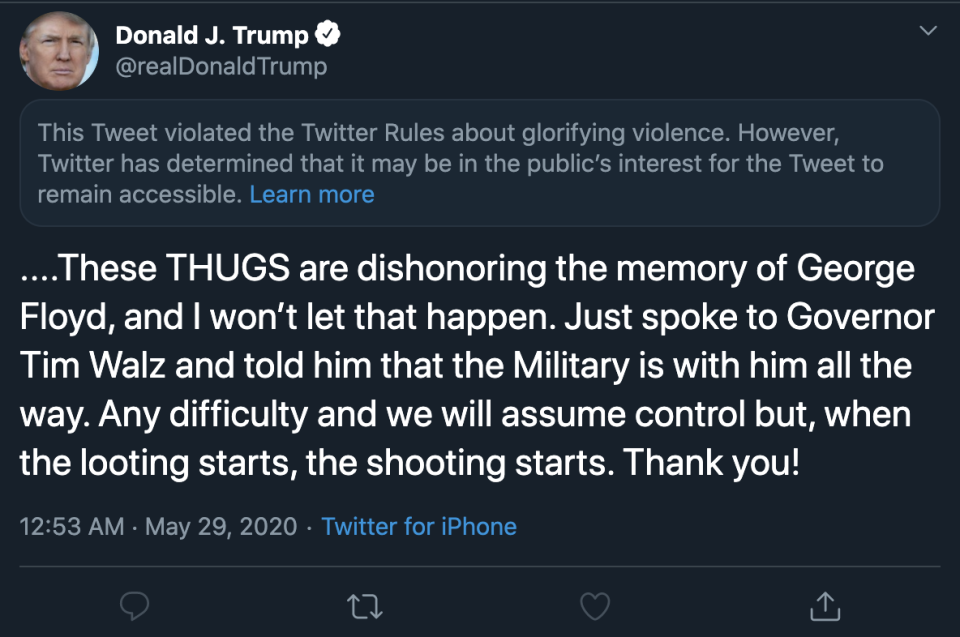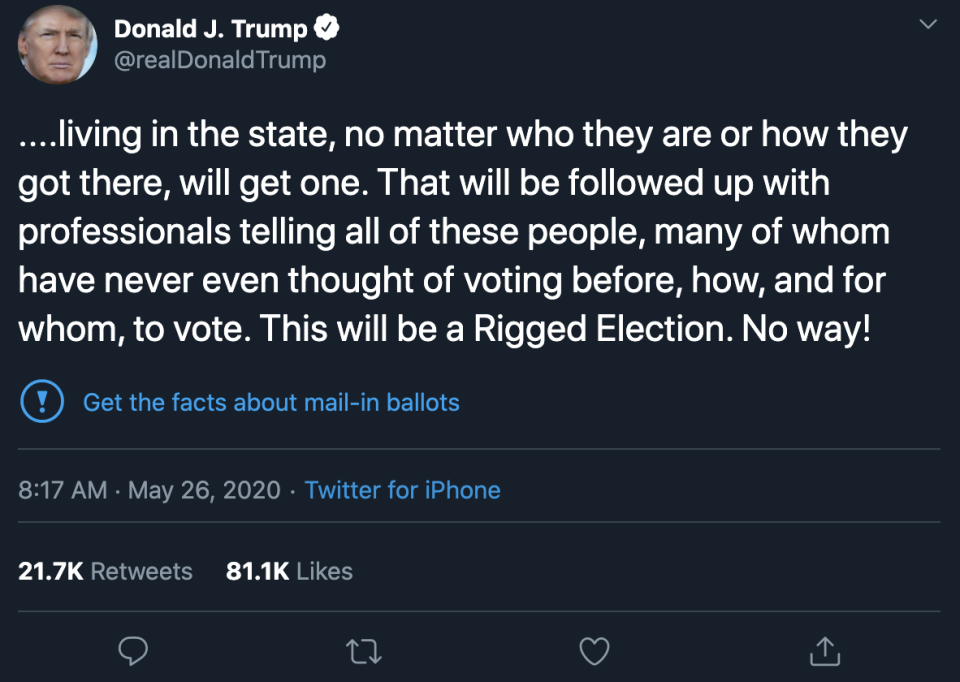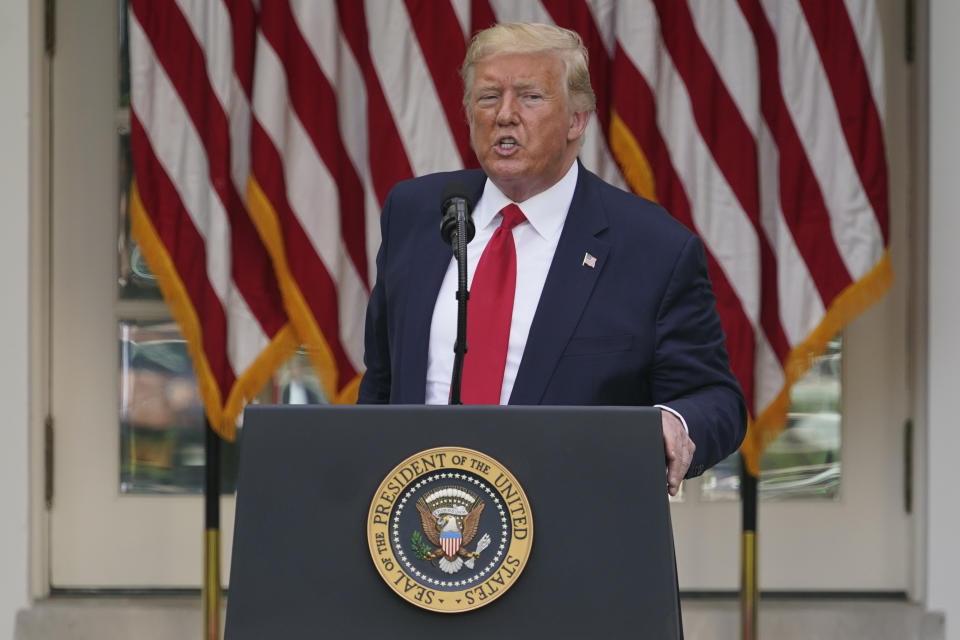Trump’s attack on Twitter could rewrite the rules of the internet
President Trump on Friday escalated his ongoing feud with Twitter (TWTR) by posting a tweet the company said glorifies violence. The company responded by blocking the tweet, which in part stated “when the looting starts, the shooting starts” from view. To see it, users must click through a warning indicating the tweet violates Twitter’s terms of service.
In response, Trump, who on Thursday signed an executive order seeking to limit the ability of internet companies to moderate content on their sites, tweeted that Section 230 of the Communications Decency Act, should be revoked.
Section 230 provides online platforms that host user-generated content, which is virtually all internet sites, with a protection against the risk of facing liability suits.

If the executive order goes unchallenged, however, it could fundamentally change the internet, and how the tech giants it created function.
“If all S 230 protections were lost, it would be an economic disaster for all who benefit from the internet,” explained John Deighton, a Harold M. Brierley professor of business administration emeritus at Harvard Business School.
Fact-checking the president
Twitter’s move to place fact-check markers on Trump’s tweets relate to the company’s civic integrity policy. According to the policy, which was updated this month, Twitter can take action against users who spread misleading information about elections.
Under the company’s current guidelines, Twitter doesn’t delete tweets by elected or government officials. Instead, it places them behind a warning that limits their reach and explains that the tweet violated the company’s terms of service.

The practice was applied to Trump’s tweets this week, adding a fact-check label, which linked to a section on Twitter’s website that explained the company’s decision-making process and offered additional links to news outlets including The Hill and CNN.
It was after that, that Trump signed his executive order.
“[Trump] can't simply declare that section 230 doesn't apply because he doesn't like being fact-checked,” Mark Lemley, William H. Neukom Professor at Stanford Law School, explained.
“The point of that section was to give internet platforms the freedom to take down offensive or malicious content without being held liable as a publisher,” he added
How companies will respond
So what happens to companies that rely on Section 230 to do business? Well, if it is repealed or substantially altered, it could change how internet companies function.
“Basically, I think anyone who advocates for essentially repealing section 230 writ large of the communication decency act does not understand the digital economy,” explained Sinan Aral, author of “The Hype Machine.”
“If you were to repeal section 230 you would have to—the first thing that would happen is there would be a slew of lawsuits and the companies would not be able to survive under that slew of lawsuits,” he added.
According to Section 230’s “good faith” rule, a company can remove user-generated content from its site if it or its users find the content objectionable or falls outside of its terms of service even if it’s considered constitutionally protected free speech.
Under the his executive order, Trump has directed the Federal Communications Commission (FCC) to set up regulations that would essentially determine what falls outside of the scope of “good faith,” and if a company runs afoul of those new regulations, they could be opened up to civil penalties through libel or other types of lawsuits.

Section 230 allows websites like Twitter to remove user-generated content like death threats, harassment, lewd images, etc. without exposing them to civil liability. Users who generate that content, though, could still be at risk of exposing themselves to lawsuits.
“If internet companies will be held liable for what is published on their products in the same way that traditional media companies are held accountable, they will have to exercise editorial control. That will add both costs and responsibilities to the organizations,” explained Rob Siegel, a lecturer in management at the Stanford Graduate School of Business.
“They may/may not have to change their business models, but it would certainly lead to less engagement from users, which would decrease revenues as the value of the advertisements these companies sell would drop due to ‘fewer eyeballs being delivered.’ “
According to Laura Edelson, a PhD candidate in computer science at NYU’s Tandon School of Engineering, internet companies would likely abide by changes to 230 so they don’t lose the liability shield it provides.
“It does not matter how onerous it would be, almost any restriction would have to be followed, because that safe harbor provision is fundamental to the business model of any company, any internet company that has user generated content,” she said.
It’s unlikely that Trump’s executive order will hold water, though. Instead, it would be up to Congress to force a change.
“[Trump] could try to get Congress to revise the law, but unless and until they do, the law says what it says.”
Got a tip? Email Daniel Howley at [email protected] or [email protected], and follow him on Twitter at @DanielHowley.
More from Dan:
Follow Yahoo Finance on Twitter, Facebook, Instagram, Flipboard, SmartNews, LinkedIn, YouTube, and reddit
